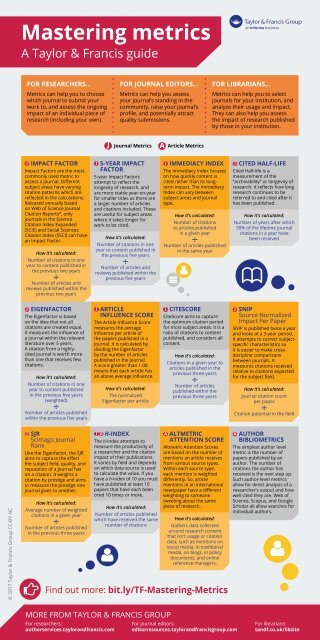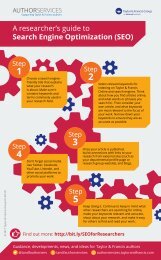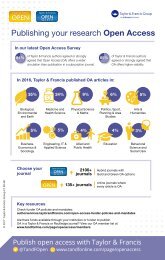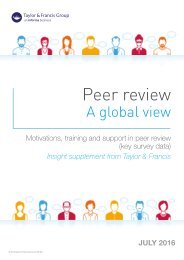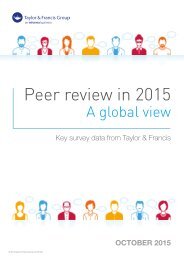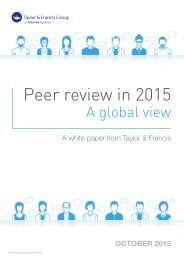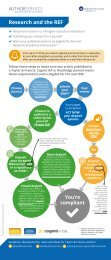Author_Services_Metrics_infographic
- No tags were found...
Create successful ePaper yourself
Turn your PDF publications into a flip-book with our unique Google optimized e-Paper software.
Mastering metrics<br />
A Taylor & Francis guide<br />
FOR RESEARCHERS…<br />
<strong>Metrics</strong> can help you to choose<br />
which journal to submit your<br />
work to, and assess the ongoing<br />
impact of an individual piece of<br />
research (including your own).<br />
FOR JOURNAL EDITORS…<br />
<strong>Metrics</strong> can help you assess<br />
your journal’s standing in the<br />
community, raise your journal’s<br />
profile, and potentially attract<br />
quality submissions.<br />
FOR LIBRARIANS…<br />
<strong>Metrics</strong> can help you to select<br />
journals for your institution, and<br />
analyze their usage and impact.<br />
They can also help you assess<br />
the impact of research published<br />
by those in your institution.<br />
J Journal <strong>Metrics</strong><br />
A Article <strong>Metrics</strong><br />
J IMPACT FACTOR<br />
Impact Factors are the most<br />
commonly used metric to<br />
assess a journal. Different<br />
subject areas have varying<br />
citation patterns which are<br />
reflected in the calculations.<br />
Released annually based<br />
on Web of Science Journal<br />
Citation Reports ® , only<br />
journals in the Science<br />
Citation Index Expanded<br />
(SCIE) and Social Sciences<br />
Citation Index (SSCI) can have<br />
an Impact Factor.<br />
How it’s calculated:<br />
Number of citations in one<br />
year to content published in<br />
the previous two years<br />
Number of articles and<br />
reviews published within the<br />
previous two years<br />
J 5-YEAR IMPACT<br />
FACTOR<br />
5-year Impact Factors<br />
attempt to reflect the<br />
longevity of research, and<br />
are more stable year-on-year<br />
for smaller titles as there are<br />
a larger number of articles<br />
and citations included. These<br />
are useful for subject areas<br />
where it takes longer for<br />
work to be cited.<br />
How it’s calculated:<br />
Number of citations in one<br />
year to content published in<br />
the previous five years<br />
Number of articles and<br />
reviews published within the<br />
previous five years<br />
J IMMEDIACY INDEX<br />
The Immediacy Index focuses<br />
on how quickly content is<br />
cited rather than its longterm<br />
impact. The Immediacy<br />
Index can vary between<br />
subject areas and journal<br />
type.<br />
How it’s calculated:<br />
Number of citations<br />
to articles published<br />
in a given year<br />
Number of articles published<br />
in the same year<br />
J CITED HALF-LIFE<br />
Cited Half-life is a<br />
measurement of the<br />
“archivability” or longevity of<br />
research. It reflects how long<br />
research continues to be<br />
referred to and cited after it<br />
has been published.<br />
How it’s calculated:<br />
Number of years after which<br />
50% of the lifetime journal<br />
citations in a year have<br />
been received<br />
J EIGENFACTOR<br />
The Eigenfactor is based<br />
on the idea that not all<br />
citations are created equal.<br />
It measures the influence of<br />
a journal within the relevant<br />
literature over 5 years.<br />
A citation from a highlycited<br />
journal is worth more<br />
than one that receives few<br />
citations.<br />
How it’s calculated:<br />
Number of citations in one<br />
year to content published<br />
in the previous five years<br />
(weighted)<br />
J ARTICLE<br />
INFLUENCE SCORE<br />
The Article Influence Score<br />
measures the average<br />
influence per article of<br />
the papers published in a<br />
journal. It is calculated by<br />
dividing the Eigenfactor<br />
by the number of articles<br />
published in the journal.<br />
A score greater than 1.00<br />
means that each article has<br />
an above average influence.<br />
J CITESCORE<br />
CiteScore aims to capture<br />
the optimum citation period<br />
for most subject areas. It is a<br />
ratio of citations to content<br />
published, and considers all<br />
content.<br />
How it’s calculated:<br />
Citations in a given year to<br />
articles published in the<br />
previous three years<br />
J SNIP<br />
Source Normalized<br />
Impact Per Paper<br />
SNIP is published twice a year<br />
and looks at a 3-year period.<br />
It attempts to correct subjectspecific<br />
characteristics so<br />
it is easier to make crossdiscipline<br />
comparisons<br />
between journals. It<br />
measures citations received<br />
relative to citations expected<br />
for the subject field.<br />
How it’s calculated:<br />
The normalized<br />
Eigenfactor per article<br />
Number of articles<br />
published within the<br />
previous three years<br />
How it’s calculated:<br />
Journal citation count<br />
per paper<br />
Number of articles published<br />
within the previous five years<br />
Citation potential in the field<br />
© 2017 Taylor & Francis Group CC-BY-NC<br />
J SJR<br />
Scimago Journal<br />
Rank<br />
Like the Eigenfactor, the SJR<br />
aims to capture the effect<br />
the subject field, quality, and<br />
reputation of a journal has<br />
on a citation. It weights a<br />
citation by prestige and aims<br />
to measure the prestige one<br />
journal gives to another.<br />
How it’s calculated:<br />
Average number of weighted<br />
citations in a given year<br />
Number of articles published<br />
in the previous three years<br />
J A H-INDEX<br />
The h-index attempts to<br />
measure the productivity of<br />
a researcher and the citation<br />
impact of their publications.<br />
It varies by field and depends<br />
on which data source is used<br />
to calculate the value. If you<br />
have a h-index of 10 you must<br />
have published at least 10<br />
papers that have each been<br />
cited 10 times or more.<br />
How it’s calculated:<br />
Number of articles published<br />
which have received the same<br />
number of citations<br />
A ALTMETRIC<br />
ATTENTION SCORE<br />
Altmetric Attention Scores<br />
are based on the number of<br />
mentions an article receives<br />
from various source types.<br />
Within each source type,<br />
each mention is weighted<br />
differently. So, article<br />
mentions in an international<br />
newspaper have a different<br />
weighting to someone<br />
tweeting about the same<br />
piece of research.<br />
How it’s calculated:<br />
Gathers data collected<br />
around research content<br />
that isn’t usage or citation<br />
data, such as mentions on<br />
social media, in traditional<br />
media, on blogs, in policy<br />
documents, and online<br />
reference managers.<br />
Find out more: bit.ly/TF-Mastering-<strong>Metrics</strong><br />
A AUTHOR<br />
BIBLIOMETRICS<br />
The simplest author level<br />
metric is the number of<br />
papers published by an<br />
author. The number of<br />
citations the author has<br />
received is the next step up.<br />
Such author-level metrics<br />
allow for direct analysis of a<br />
researcher’s output and how<br />
well cited they are. Web of<br />
Science, Scopus, and Google<br />
Scholar all allow searches for<br />
individual authors.<br />
MORE FROM TAYLOR & FRANCIS GROUP


